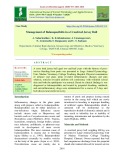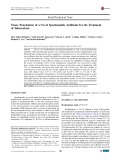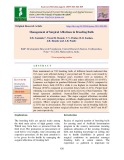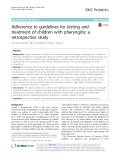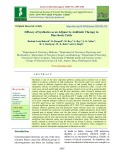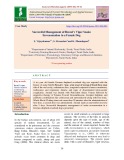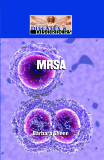
Antibiotics administered
-
Antibiotics administered incorrectly may result in detrimental consequences, such as prolonging treatment duration, causing adverse effects, or even increasing mortality. The research aimed to examine the characteristics of the antibiotics list utilized at PDHC in 2019.
 7p
7p  viwarmachine
viwarmachine
 03-07-2023
03-07-2023
 3
3
 2
2
 Download
Download
-
Antibiotics exposure has been implicated in the emergence of bacterial strains that are resistant to structurally related or unrelated antibiotics. Tylosin is a macrolide antibiotic that has been administered to treat respiratory pathogenic bacteria in swine.
 8p
8p  vigalileogalilei
vigalileogalilei
 28-02-2022
28-02-2022
 23
23
 1
1
 Download
Download
-
A cross bred jersey bull aged two and half years with the history of postservice bleeding from penis was presented to Large Animal Gynaecology Unit, Madras Veterinary College Teaching Hospital. Physical examination of prepuce and glans penis revealed inflammatory changes and pain whereas, testicles revealed uniform soft consistency with wrinkled scrotal skin and both the epididymis was normal.
 3p
3p  kethamoi7
kethamoi7
 26-08-2020
26-08-2020
 6
6
 2
2
 Download
Download
-
The in vivo biodistribution and pharmacokinetics of 1329, a novel spectinamide antibiotic with anti-tubercular activity, were studied during intravenous administration of an tritium-labeled compound for nine consecutive, 12-hourly doses to rats. Serial blood samples were collected after the first and the eighth dose, and major organs and tissues were collected 1 h after the ninth dose. Urinary and fecal excretion was monitored throughout the dosing period. Radioactivity in the collected samples was assessed by scintillation counting. During the course of treatment, 86.
 4p
4p  caothientrangnguyen
caothientrangnguyen
 09-05-2020
09-05-2020
 10
10
 1
1
 Download
Download
-
The present study was conducted in 18 cows, divided into three groups (I,II and III ) of six animals each based on the type of internal obstructive lesion viz; focal (Type I), diffuse (Type II) and membranous (Type III) respectively. The location and morphometry of the obstructive lesion was confirmed by ultrasonographical examination. Axial theloscopy of the teat was performed to visualize the nature, location and extent of lesion.
 13p
13p  caygaocaolon4
caygaocaolon4
 04-04-2020
04-04-2020
 10
10
 0
0
 Download
Download
-
An estimated 2.7 of the 5.9 million deaths in children under 5 years of age occur in the neonatal period. Severe infections contribute to almost a quarter of these deaths. Mortality due to severe infections in developing country settings is substantial despite antibiotic therapy.
 10p
10p  vimax2711
vimax2711
 30-03-2020
30-03-2020
 10
10
 1
1
 Download
Download
-
Data maintained on 742 breeding bulls of different breeds indicated that 213 cases were affected during 3 year period and 78 cases were treated by surgical interventions. Surgical cases recorded were as lameness 51 (23.94%), major affections 09 (4.23%) and minor affections 18 (8.45%). Lameness was highest in purebred Holstein Friesian (7.04%) compared to purebred Jersey bulls (0.94%), while it was highest in crossbred Holstein Friesian (8.92%) compared to crossbred Jersey bulls (1.41%). Proper hoof trimming was mainly essential tool in early recovery of hoof lameness.
 4p
4p  cothumenhmong3
cothumenhmong3
 22-02-2020
22-02-2020
 15
15
 1
1
 Download
Download
-
Group A streptococcus (GAS) is the most common bacterial etiology of pharyngitis but is difficult to distinguish clinically from viral pharyngitis. There are benefits to early antibacterial treatment of GAS pharyngitis, but administering antibiotics to children with viral pharyngitis is ineffective and costly.
 7p
7p  vidr2711
vidr2711
 19-02-2020
19-02-2020
 63
63
 1
1
 Download
Download
-
Diarrhoea is one of the most important problem causing great economic loss to dairy industry by drastic reduction in milk production. The present study was carried out in cattle reared at different organized dairy farms in and around Durg to evaluate the therapeutic efficacy of synbiotics along with antibiotic in diarrhoeic cattle. A total of 18 cattle were selected and divided into three groups. Group I (n=6) served as normal healthy control whereas group (n=6) II and III were diarrhoeic cattle.
 12p
12p  nguaconbaynhay3
nguaconbaynhay3
 07-02-2020
07-02-2020
 10
10
 1
1
 Download
Download
-
A six year old female German shepherd crossbred dog was reported with the history of snake bite by Russell’s viper, acute onset of oozing of blood from inner side of the oral cavity, oedematous face, congested conjunctival mucus membrane, restlessness and respiratory distress and signs of disseminated intravascular coagulation. Animal was treated with Polyvalent Snake Venom followed by supportive therapy of Tetanus Toxoid, Dexamethasone, Atropine Sulphate, and antibiotic combinations like ceftriaxone and metronidazole along with liver tonic.
 3p
3p  nguathienthan2
nguathienthan2
 26-12-2019
26-12-2019
 8
8
 0
0
 Download
Download
-
In January 2005 Peg McQueary nicked her ankle while shaving. It was a tiny cut, but that little opening in her skin provided a perfect entry point for dangerous bacteria. Two weeks later McQueary developed a pus-filled boil on her ankle. Shortly thereafter, her leg swelled to three times its normal size. It was hot, tender, and painful. McQueary went to see her doctor. He rushed her to the hospital, where she was intravenously administered vancomycin, a powerful antibiotic. It took more than a month for Mc- Queary’s leg to heal....
 105p
105p  crius75
crius75
 03-01-2013
03-01-2013
 46
46
 5
5
 Download
Download
-
Tetanus: Treatment General Measures The goals of therapy are to eliminate the source of toxin, neutralize unbound toxin, and prevent muscle spasms while monitoring the patient's condition and providing support—especially respiratory support—until recovery. Patients should be admitted to a quiet room in an intensive care unit, where observation and cardiopulmonary monitoring can be maintained continuously but stimulation can be minimized. Protection of the airway is vital. Wounds should be explored, carefully cleansed, and thoroughly debrided.
 5p
5p  colgate_colgate
colgate_colgate
 21-12-2010
21-12-2010
 63
63
 2
2
 Download
Download
-
Primary Bacterial Peritonitis: Treatment Treatment for PBP is directed at the isolate from blood or peritoneal fluid. Gram's staining of peritoneal fluid often gives negative results in PBP. Therefore, until culture results become available, therapy should cover gram-negative aerobic bacilli and gram-positive cocci. Third-generation cephalosporins such as cefotaxime (2 g q8h, administered IV) provide reasonable initial coverage in moderately ill patients. Broad-spectrum antibiotics, such as penicillin/β-lactamase inhibitor combinations (e.g., piperacillin/tazobactam, 3.
 5p
5p  thanhongan
thanhongan
 07-12-2010
07-12-2010
 80
80
 3
3
 Download
Download
-
The Acutely Ill Patient: Treatment In the acutely ill patient, empirical antibiotic therapy is critical and should be administered without undue delay. Increased prevalence of antibiotic resistance in community-acquired bacteria must be considered when antibiotics are selected. Table 115-1 lists first-line treatments for infections considered in this chapter. In addition to the rapid initiation of antibiotic therapy, several of these infections require urgent surgical attention.
 13p
13p  thanhongan
thanhongan
 07-12-2010
07-12-2010
 67
67
 2
2
 Download
Download
-
Introduction: β-Lactum antibiotics constitute an important class of antibacterial agents being used extensively for both humans and food-producing animals to treat or prevent infections. The drugs occasionally cause human deaths due to anaphylactic shock during medical treatments, especially when they are parenterally administered without their prior intracutaneous tests. These cases are usually handled as medical accidents (malpractice), and subjected to autopsies and analysis of the drugs used. These antibiotics are composed of cephems ( Table 10.1) and penicillins ( Table 10.
 8p
8p  bigbaby87
bigbaby87
 01-09-2010
01-09-2010
 101
101
 6
6
 Download
Download
CHỦ ĐỀ BẠN MUỐN TÌM










